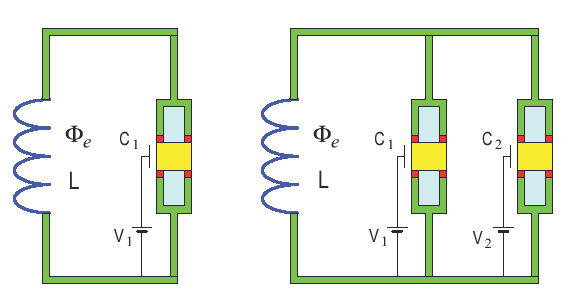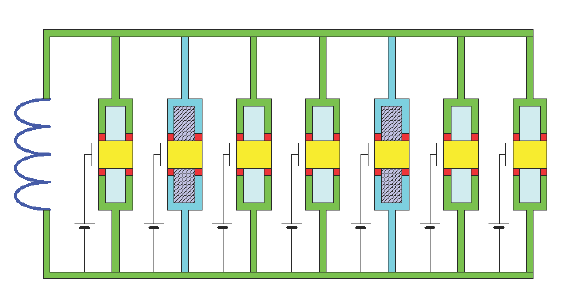Scalable quantum computing with Josephson charge qubits
|
Full paper: Scalable quantum computing using Josephson charge qubits. A goal of quantum information technology is to control the quantum state of a system, including its preparation, manipulation, and measurement. However, scalability to many qubits and controlled connectivity between any selected qubits are two of the major stumbling blocks to achieve quantum computing (QC). Here we propose an experimental method, using Josephson charge qubits, to efficiently solve these two central problems. The proposed QC architecture is scalable since any two charge qubits can be effectively coupled by an experimentally accessible inductance. More importantly, we formulate an efficient and realizable QC scheme that requires only one (instead of two or more) two-bit operation to implement conditional gates.
Figure 1. This is a schematic diagram of two micro-circuits, one with one qubit (left) and the other with two coupled qubits (right). Using a plumbing analogy, with an electrical charge taking the place of water, the yellow box is like a reservoir, storing charge (actually, storing pairs of superconducting electrons). This charge can be pushed in and out of the box using a pump (the voltage, V1) that moves the charge through the “valves” or “faucets” (the red boxes, known as Josephson junctions) and into the superconducting wires acting as “pipes.” The blue magnetic field controls the strength of the red barriers, and thus can control the flow of electrons in and out of the yellow charge box.
Figure 2. This is a schematic diagram of a micro-circuit with seven qubits. The applied magnetic field (shown in blue) can be chosen to have two specific values. One value closes the red “faucets” of each yellow charge storage box. The other value selects two qubits by opening the corresponding red valves, so electronic charge can come in and out (controlled by the voltages that act as “charge pumps”). Thus, two qubits, from the total of seven, are coupled with each other. This idea can be extended to an arbitrary number of qubits. For details, see full paper: Scalable quantum computing using Josephson charge qubits. |
|
Copyright (c) DML, Japan. All rights reserved.
Digital Material Laboratory |

